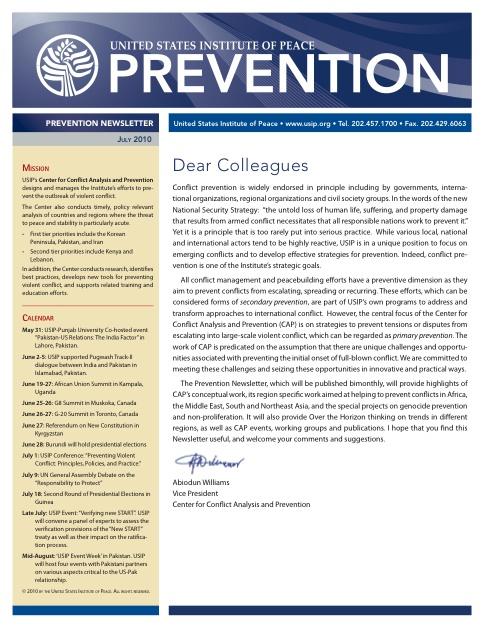The bimonthly Prevention Newsletter provides highlights of CAP's conceptual work, its region specific work aimed at helping to prevent conflicts in Africa, the Middle East, South and Northeast Asia, and the special projects on genocide prevention and nonproliferation. It also provides Over the Horizon thinking on trends in different regions, as well as CAP events, working groups and publications.
In this Issue
- SPOTLIGHT on Pakistan: There is perhaps no other country whose fortunes will have as much bearing on global security in the near to medium term as Pakistan. If Pakistan is unable to address its multiple challenges, weaknesses and failures, it will likely descend into pervasive conflict with implications far beyond its borders. Therefore, U.S. efforts to forge a broad strategic partnership with Pakistan that addresses, along with the terrorist threat, the country’s economic and social challenges ought to be viewed as an intervention aimed at conflict prevention.
- HIGHLIGHTS on
- Political Struggles in Iran
- U.S.-ROK Relations
- Rising Tensions in Lebanon
- U.S.-Turkish Relations
- Preventing Electoral Violence in Côte D'Ivoire and Kenya
- Recent Developments in Chad
- Quadrennial Diplomacy and Development Review (QDDR)
- Quadrennial Defense Review (QDR) Independent Panel
- Nonproliferation and Arms Control
About This Newsletter
The bimonthly Prevention Newsletter provides highlights of USIP's Center for Conflict Analysis and Prevention's conceptual work, its region specific work aimed at helping to prevent conflicts in Africa, the Middle East, South and Northeast Asia, and the special projects on genocide prevention and non-proliferation. It also provides Over the Horizon thinking on trends in different regions, as well as CAP events, working groups and publications. Every Newsletter will spotlight a single country, conflict, or event in the spotlights, and include short highlights of all regions and issues covered by the Center.
